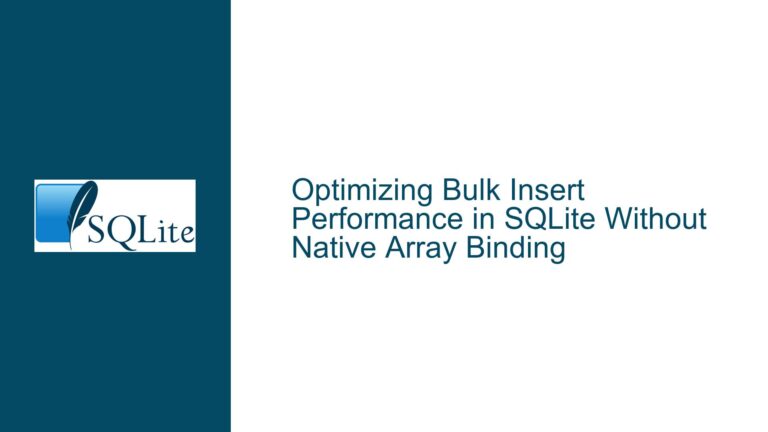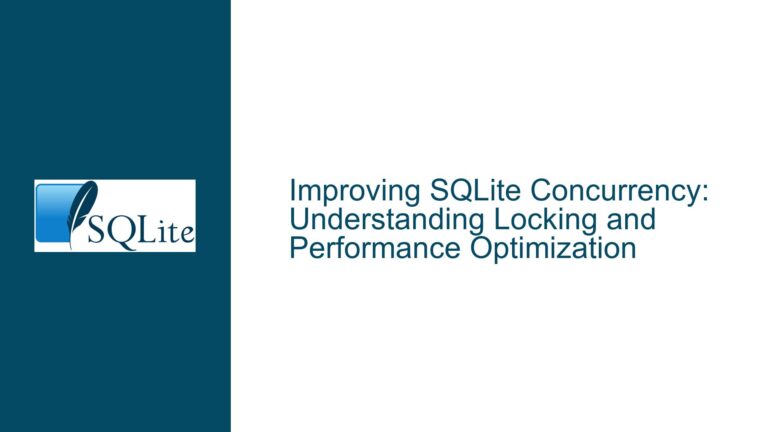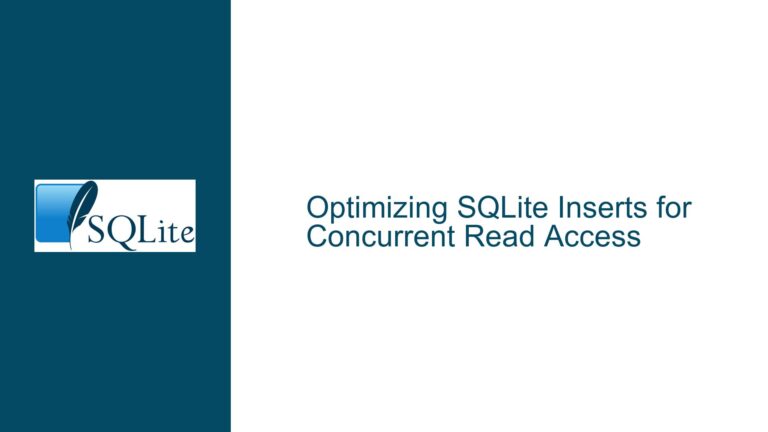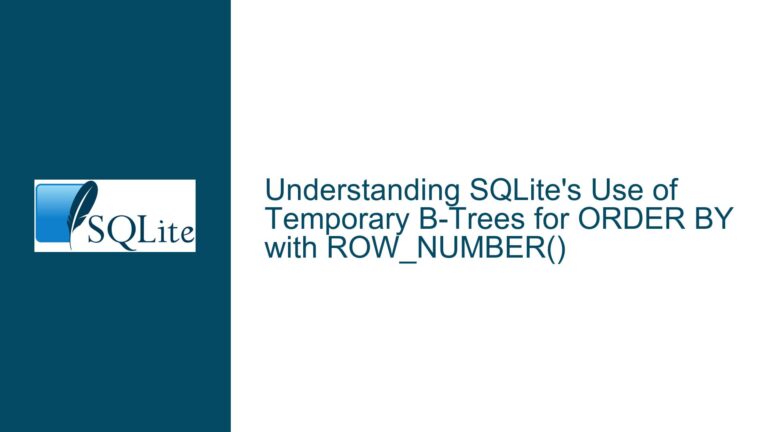SQLite Database Access: mmap() vs fread()/fwrite() and Shared Memory Handling
SQLite’s Use of mmap() and fread()/fwrite() for Database Access
SQLite, a lightweight, serverless, and self-contained SQL database engine, employs different mechanisms for accessing database files depending on the configuration and operating system. Two primary methods are discussed: mmap() and fread()/fwrite(). Understanding how SQLite uses these methods is crucial for optimizing performance and ensuring data integrity.
The mmap() function maps a file or device into memory, allowing direct access to the file’s contents as if it were an array in memory. This method can significantly improve performance by reducing the overhead associated with traditional file I/O operations. However, mmap() comes with its own set of challenges, particularly when dealing with I/O errors. When an I/O error occurs during a mmap() operation, the application receives a signal rather than an error code, making it difficult for SQLite to handle the error gracefully. This can lead to application crashes, which is why SQLite defaults to using fread() and fwrite() for most operations.
On the other hand, fread() and fwrite() are standard C library functions that read from and write to files using file descriptors. These functions return error codes when an I/O error occurs, allowing SQLite to detect and handle errors more gracefully. This makes fread() and fwrite() a safer choice for database operations, especially in environments where I/O errors are more likely, such as when using removable storage devices.
SQLite provides the PRAGMA mmap_size directive, which allows users to configure the size of the database file that should be memory-mapped. Setting PRAGMA mmap_size=N enables memory mapping for the first N bytes of the database file. If mmap_size is set to 0, memory mapping is disabled, and SQLite will use fread() and fwrite() exclusively. The ability to use mmap() is system-dependent; SQLite disables this feature on systems where the underlying OS does not support a coherent page cache.
In Write-Ahead Logging (WAL) mode, SQLite always uses mmap() for the WAL index, unless it is explicitly disabled. The WAL index is a critical component of the WAL mode, which allows multiple readers and a single writer to access the database concurrently. The use of mmap() in this context is essential for performance, as it allows multiple processes to share the same memory-mapped WAL index, reducing the need for redundant I/O operations.
Interrupted Write Operations and I/O Errors in SQLite
One of the primary concerns when using mmap() in SQLite is the handling of I/O errors. When an I/O error occurs during a mmap() operation, the application receives a signal, which can lead to an abrupt crash if not handled properly. This is in contrast to fread() and fwrite(), which return error codes that SQLite can catch and handle gracefully.
For example, consider a scenario where a database is stored on a USB memory stick, and the stick is abruptly removed during a read operation. If SQLite is using fread(), it will receive an error code indicating the I/O failure. SQLite can then unwind its stack, release any held locks, and return a sensible error to the calling application. However, if SQLite is using mmap(), the application will receive a signal, and SQLite will not have the opportunity to recover gracefully. This can result in data corruption or an application crash.
To mitigate this risk, SQLite defaults to using fread() and fwrite() for most operations, especially in environments where I/O errors are more likely. However, in environments where I/O errors are rare and performance is critical, mmap() can be enabled using the PRAGMA mmap_size directive. It is important to weigh the performance benefits of mmap() against the potential risks of I/O errors when configuring SQLite for a specific use case.
Shared Memory Handling in SQLite with shm_open() and mmap()
When multiple processes access the same SQLite database, particularly in WAL mode, SQLite uses shared memory to coordinate access to the WAL index. The shm_open() function is used to create and open a shared memory object, which is then memory-mapped into the address space of each process using mmap(). This allows multiple processes to share the same WAL index, reducing the need for redundant I/O operations and improving performance.
The WAL index is a critical component of the WAL mode, which allows multiple readers and a single writer to access the database concurrently. The WAL index is used to track the current state of the database, including which pages have been modified and need to be written back to the main database file. By sharing the WAL index among multiple processes, SQLite ensures that all processes have a consistent view of the database state, even as changes are being made.
However, when a process needs to modify a page in the WAL index, it must first copy the page into its private memory. This is necessary because changes made to the shared memory-mapped pages would be immediately visible to all other processes, potentially leading to inconsistencies. By copying the page into private memory, the process can make changes without affecting other processes until the changes are committed.
This approach ensures that changes to the WAL index are only visible to other processes after they have been committed, maintaining the consistency and integrity of the database. The use of shm_open() and mmap() in this context is essential for the performance and scalability of SQLite in multi-process environments.
Implementing PRAGMA mmap_size and Database Backup Strategies
To configure SQLite to use mmap() for database access, the PRAGMA mmap_size directive can be used. This directive allows users to specify the size of the database file that should be memory-mapped. Setting PRAGMA mmap_size=N enables memory mapping for the first N bytes of the database file. If mmap_size is set to 0, memory mapping is disabled, and SQLite will use fread() and fwrite() exclusively.
When using mmap(), it is important to consider the potential risks of I/O errors and application crashes. To mitigate these risks, it is recommended to implement robust database backup strategies. Regular backups ensure that data can be recovered in the event of a crash or data corruption. SQLite provides several mechanisms for creating backups, including the sqlite3_backup API and the .dump command in the SQLite shell.
The sqlite3_backup API allows for online backups, where the database can be backed up while it is still in use. This is particularly useful for applications that require high availability. The .dump command, on the other hand, generates a SQL script that can be used to recreate the database. This method is useful for creating offline backups or for transferring the database to another system.
In addition to regular backups, it is also important to monitor the health of the database and the underlying storage system. Tools such as sqlite3_analyzer can be used to analyze the database file and identify potential issues, such as fragmentation or corruption. Monitoring the storage system for signs of failure, such as bad sectors or I/O errors, can also help prevent data loss.
Conclusion
SQLite’s use of mmap() and fread()/fwrite() for database access offers a trade-off between performance and reliability. While mmap() can provide significant performance benefits, it also introduces the risk of application crashes in the event of I/O errors. SQLite’s default use of fread() and fwrite() ensures that errors can be handled gracefully, making it a safer choice for most environments.
In multi-process environments, SQLite’s use of shm_open() and mmap() for shared memory handling is essential for maintaining consistency and performance. By sharing the WAL index among multiple processes, SQLite ensures that all processes have a consistent view of the database state, even as changes are being made.
To configure SQLite to use mmap(), the PRAGMA mmap_size directive can be used. However, it is important to weigh the performance benefits against the potential risks and to implement robust database backup strategies to mitigate these risks. Regular backups, monitoring, and analysis are essential for maintaining the health and integrity of the database.
By understanding the nuances of SQLite’s database access mechanisms and implementing appropriate configurations and backup strategies, developers can optimize the performance and reliability of their SQLite databases.






